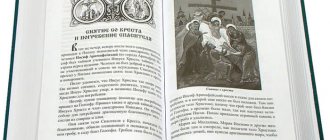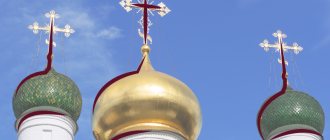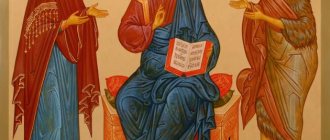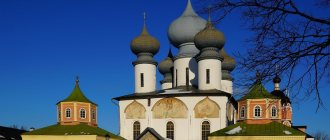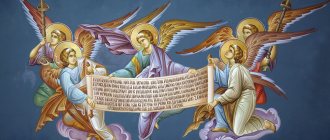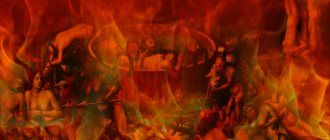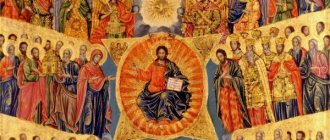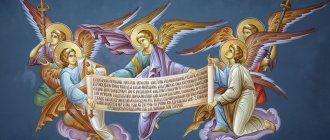Symbolism of icons
Download in Microsoft Word format
In Orthodox iconography, gestures, colors, and objects in symbolic meaning are not unconditional. Like Holy Scripture, the icon has several methods of interpretation: literal, allegorical, moral, spiritual.
| Space | The space in the icon is displayed using reverse (the visual position is transferred as if inside what is happening), spherical and direct perspective. |
| Time | Some icons are characterized by the simultaneity of the image: all events occur at once, which emphasizes their common spiritual unity. Often an icon shows the events of several days or even the entire life of a saint, sequentially depicting events on the icon itself or in stamps. |
| Composition | The timeless and extra-spatial perception of the icon is also facilitated by its composition, which is distinguished by its complete completeness and detachment from everything external and its peculiar melody. The closed composition and rhythm give the icon a character detached from earthly life, the opposite of rough naturalism. |
| Background | The golden background of the icon represents the radiance of the glory of God, as the immersion of the world in the effective power of Divine energies. |
| Light | Light is one of the names of God. There are no shadows in the heavenly world. The icon reveals saints sanctified by divine grace, and not by sensual light. A ray from the heavenly spheres is a symbol of divine grace. Three rays indicate that in any divine action one should see the participation of all divine Persons. |
| Symbolism of color | In each icon, the symbolic solution of color is different and is emphasized by other visual means. Therefore, in order to understand what a particular color symbolizes, one must focus not only on the general trend, but also on the semantic and compositional context of each specific icon. |
| Symbols of holiness | The radiance in the form of a circle around the head is a halo. A halo is a reflection of the radiance of the uncreated Divine light, which transforms a person who unites with God. The cross in the Savior’s halo (baptized halo) is an indication of His sacrifice on the Cross. Sometimes on Trinity icons all three Angels are given baptized halos, symbolizing the Three Persons of the Holy Trinity. The square halo is in the Western tradition among donors (ktitors). Mandorla is an almond-shaped radiance among which Christ and the Mother of God are depicted when they want to present them in glory. |
| Symbolism of gestures | A hand pressed to the chest means heartfelt empathy, contrition. A hand raised up is a call to repentance. A hand extended forward with an open palm is a sign of obedience and submission. Two hands raised up - enhanced prayer. Hands raised forward - a prayer for help, a gesture of request. Hands pressed to the cheeks are a sign of sadness, grief. |
| Symbolism of objects | Oak - on the icons of the Trinity symbolizes the tree of life, literally - the Mamrian oak. A house is a symbol of house-building, a man-made world, a church, a heavenly abode. The mountain is a symbol of spiritual and moral ascent. The golden crown is a symbol of spiritual victory. The red cross is a symbol of martyrdom, royal dignity. The anemone flower is a sign of the sorrow of the Mother of God (usually on the icons “Crucifixion” and “Descent from the Cross”). A young man with a trumpet is the wind (on the icons of the Last Judgment). A spear in the hands of a saint means victory over dark forces. The pointing finger (right hand) descending from heaven is Divine providence. The ladder is spiritual elevation and the desire for God. The cave is often an allegory of the underworld. The Vine is Christ and His Church. Bunches of grapes are symbols of the church and the Eucharist. The angel's staff is a symbol of heavenly messengership. The rod in the hands of an angel is a symbol of power and dignity. Archangel Gabriel or Michael can be seen on icons with a globe (often light and transparent, like a glass ball or sphere) or a mirror, representing the celestial sphere, symbolizing the universe or shield. Trumpets in the hands of angels are symbols of sound and wind. During the Last Judgment, angels, including the Archangel Michael, blow trumpets. Sometimes angels are depicted with the instruments of Christ's Passion. Most often, the archangels Michael and Gabriel hold the cross, spear, cup and cane with a sponge. Unrolled scrolls in the hands of angels contain words of greeting, hymns of praise, and teachings for those entering the temple. |
| Images from Scripture | Golden cross, anchor and heart - faith, hope and love. The book is the Gospel, the Book of Life, the spirit of wisdom. Golden candlestick – Holy Spirit (seven candles – seven gifts of the Holy Spirit). The horn is a symbol of fortress. Thunder arrows are the spirit of God's wrath. A blueberry holding a branch in its mouth is a symbol of peace and God's mercy. |
| Location symbols | Pointing out, just like the landscape, that the action taking place in the icon is historically connected with a certain place, architecture never contains the fullness of this action. It only serves as a background for it, because by the very meaning of the icon, the action is not isolated, not limited to place, just like what appears in time, it is not limited to time. Therefore, an event in front of a temple or building where the front wall is removed means that it occurs inside the temple or building. An event in front of a cave can mean in a cave. Two or three trees can symbolize a forest. If we compare how the human figure is conveyed in the icon and how the building is conveyed, we will see a big difference between them: the human figure, with rare exceptions, is always correctly constructed, everything in it is in its place; the same goes for clothes. The architecture, both in its forms and in their distribution, is emphatically illogical. Doors and windows are often punched out of place, their size does not correspond to their purpose, etc. The meaning of this phenomenon is that architecture is the only element in the icon with which it can be clearly shown that the action taking place before our eyes is outside the laws earthly logic, outside the laws of earthly existence. |
| Right and left side | Can indicate righteousness and sinfulness. For example, to the left of Christ are the foolish virgins, to the right are the reasonable ones. Or people on icons of the Last Judgment. |
| Symbol of the Ever-Virginity of the Virgin Mary | The three stars on the maforia of the Virgin Mary are a symbol of Her virginity before, during and after the Nativity of Christ. |
| Folds in clothes | They are not random and disorderly, but subordinate to the general harmony of the image of the saint; their rhythmicity and movement are emphasized. The nature of the arrangement of folds on the clothes of the saints indicates the time of painting of the icon. In the 8th–14th centuries, folds were drawn frequently and small. They talk about strong spiritual experiences and a lack of spiritual peace. In the 15th–16th centuries, folds were drawn straight, long, and sparse. All the elasticity of spiritual energy seems to break through them. They convey the fullness of ordered spiritual forces. |
| Position of figures on the icon | The saints are turned directly or three-quarters towards us. An icon is a means for prayerful communication; when we pray, we meet the saints face to face. The profile means the absence of direct communication and is used only in compositions, usually by non-holy persons - the Magi, the shepherds. |
| Animals | Pelican is a symbol of eternal life, resurrection, love of children. The symbols of the Evangelists are more often: Matthew - an angel, Mark - a lion, Luke - a calf, John - an eagle. |
| Symbolism of Church Sacraments | A vessel with water - the Sacrament of Baptism. Alabaster vessel (vessel with a long neck) – Sacrament of Confirmation. Chalice and paten - Sacrament of Communion. Vessel with oil - the Sacrament of Blessing of Unction (unction). |
| Symbolism of celestial bodies | The images of the luminaries emphasize that they are only part of creation; celestial bodies participate in “universal worship” and submit to the will of the Creator. The Crucifixion scene almost always contains two discs. These are the signs of the sun and moon. |
| Movement | The physical movement on the icon is subordinated to the general meaning of the composition and the particular meaning of the given character. But the movement of the spirit is conveyed by special means - the pose of the figure, hands, folds of clothing, color and most importantly - the eyes. All the power of moral achievement, all the power of the spirit and its power over the body are concentrated there. |
| Robes | Robes allow you to emphasize the status of the one depicted on the icon. A fur coat or purple mantle is an attribute of holy princes, a cloak is an attribute of warriors, and a white himation symbolizes martyrdom. The angels on the icons are dressed in luxurious clothes of Byzantine courtiers (which symbolizes their service to the Heavenly King). Demons, on the contrary, are written naked, since “naked of all good” (this symbol should be taken in context, since the first parents Adam and Eve are depicted naked in Eden, but in this case it means innocence and purity of thoughts before the Fall). |
| Symbols that allow you to personify the central image of the icon | It is customary to depict St. Sergius of Radonezh holding the monastery he founded in the palm of his hand, righteous Noah holds the ark in his hand, the prophet Moses holds the tablets of the Testament, the healer and great martyr Panteleimon is traditionally depicted with a box of medicines, St. Andrei Rublev - with the icon of the Holy Trinity, and St. Seraphim of Sarov - with a scroll of sayings and prayers. |
See also:
- Symbolism of the icon Deacon Andrey
- Icon veneration and icon painting in the liturgical life of the Church A handbook for a clergyman
- Photo quiz “Symbolism of an icon”
- Test: Christian symbolism
Color and its symbolism in icon painting
In my publications I want to continue to introduce you to the icon. Today I want to dwell on color and its symbolism in icon painting. Many have probably asked themselves the question - why are some icons so dark? Why can’t your saint have, for example, a pink or lilac cloak instead of a red one, because this is my favorite color and I want to see it on my icon. So, excessive beauty clearly harms the icon, distracting the inner gaze from the revealing Mystery. The beauty of the icon lies in the extremely strict hierarchical balance of color, individual shapes, light, and lines. This is a special language, the elements of which are rooted in Sophia (Wisdom) and express it in the same way as words express thought.
The symbolism of color in the icon, as well as the composition and plasticity, reflect Divine wisdom. Each color has its own place, its own meaning. The colors in the icon were never mixed. Spectral analysis showed that the colors in the ancient icon overlapped one another. The lower layer glowed from under the upper one. Until now, visiting museums, we can observe this technique, for example, on the clothes of saints - the color seems to be green, but yellow is visible underneath it. That is, blue superimposed on yellow gave green color to the clothes. Thus, the icon painter was able to obtain the required number of color shades for the most complete disclosure of images. This is how a harmonious transfer of the color of our “created World” onto the icon was achieved. To obtain colors, painters mix paints with each other; in our opinion, this is “worldly”, and applying paints to each other gives them a certain “unearthly” shade. Now, continuing traditions, real icon painters paint exactly this way - with glazes, that is, superimposing one color on another, achieving the desired shade. In order to achieve a more unearthly effect, to show that the saint is depicted in another heavenly world, spaces (highlighting volumetric areas) of a different color are applied to the colored draperies of the clothes.
So let's get started.
The main color in the icon is gold, we most often see it on the icon, since it is it that symbolizes the color of the kingdom of God, God’s presence, the light of eternity and grace. The background of icons is often covered with gold, as if speaking about the unearthly light of the heavenly world. After gold, the most common are ocher or ocher-yellow backgrounds - these colors on the backgrounds carry the same meaning, and their appearance is due to the fact that previously those who did not have the means to purchase a gilded icon simply asked to paint a more “budget option”. After all, icons were a must in every home, and due to poverty, some people could only afford the simplest painting. Halos are made over the heads of saints with gold or ocher, also showing us an unearthly glow.
We also see gold on the robes of the Mother of God and the Savior, the wings of Angels, stools, thrones, gospels, and crucifixes. Also, sometimes we see golden rays on the clothes of saints, gospels, and wings of angels - these strokes are called assists. They depict the uncreated Light, the presence of the Divine itself in the radiance of Divine rays.
The next color is white. White color is a symbol of Divine light, glow. It is the color of purity, holiness and simplicity. On icons and frescoes, saints and righteous people were usually depicted in white as the Righteous - people who are kind and honest, living “in truth.” The swaddling clothes of babies, the souls of dead people, shone in the same white color (for example, on the icon of the “Assumption of the Virgin Mary”, where Christ himself accepted the soul of his mother in the form of a swaddled baby, and angels. But only righteous souls were depicted in white. A similar meaning is also carried by the silver color which is a symbol of the purity of the flesh and evangelical eloquence - “The words of the Lord are pure words, silver purified from the earth in a furnace, refined seven times” (Ps. 11:7)
Blue and cyan colors meant the infinity of the sky, a symbol of another, eternal world. The blue color symbolizes the desire for God, a symbol of heaven. The Savior's clothes are a blue himation, a symbol of his Divinity. Blue also symbolizes mystery, wisdom and revelation. This is also the color of the apostolic robes. Blue color is considered the color of the Virgin Mary, as it symbolizes heavenly purity. The backgrounds of icons were made with blue, just like gold and ocher, carrying the same meaning of heavenly light and purity. But the blue pigment was more expensive than the ocher pigment because it was more difficult to obtain. Until now, lapis lazuli and blue mineral pigments are not cheap in price. The backgrounds of the paintings in many churches dedicated to the Mother of God are made with blue and light blue flowers. The blue color combined with purple produces cherry, which is also used to describe the robes of the Mother of God. The combination of blue and cherry flowers symbolizes the connection of the earthly and heavenly. It is customary to paint the robes of the Mother of God in both blue (for example, as in the icons of the Intercession or the Unfading Color) and burgundy. Both options are fully consistent with the iconographic canon.
Red is one of the most noticeable and frequently occurring colors in the icon. This is the color of warmth, love, fire, life-giving energy. That is why the color red became a symbol of the Resurrection - the victory of life over death. The first painted eggs were always painted red, as we can read about in the parable of the myrrh-bearing Mary Magdalene. But at the same time, it is the color of blood and torment, the color of Christ’s sacrifice. Martyrs are depicted in red robes on icons; the Savior’s dark red tunic is a symbol of his human nature. The wings of the seraphim archangels close to the throne of God shine with red heavenly fire. Sometimes they painted red backgrounds - as a sign of the triumph of eternal life. The red color, which carries the nature of fire, also has another meaning - threat, blood, fire, therefore it is also used in icons depicting the Last Judgment, telling us about the torment and suffering of hell.
The color purple (burgundy, crimson) was very important in Byzantine culture and gradually passed into Russian icon painting. This is the color of God in heaven, the emperor and ruler on earth. Only the emperor could wear purple clothes, sit on a purple throne, and sign decrees in purple ink. Hence, in Russian icon painting, the tradition arose of painting clothes and shoes of holy kings and princes in this color. Cinnabar was the most expensive color, as this mercurial mineral was difficult to obtain. Therefore, it served its purpose. Cinnabar has a shade from red to bright scarlet. Currently, it is being replaced by cadmium red, but dedicated icon painters still use cinnabar to convey unique red shades. In the old days, leather or wooden bindings of the Gospels in churches were covered with purple cloth, which is how they are depicted on icons as the most expensive and significant thing. This color is also used for the clothes of the Mother of God, Queen of Heaven.
Green is the natural, living color of the Holy Spirit. On the Feast of the Holy Trinity and the Spirits, the temples are dressed in green, decorated with fresh herbs, and the priests put on green vestments. This is the color of grass and leaves, flowering, eternal renewal. Green was used to write "pozem" - earth; it was present where life began - in the scenes of the Nativity. The vine is written in green as a symbol, the tree of life. It means a symbol of eternal life, the victory of life over death given to us by the Savior.
The color brown reminds us of the frailty of human nature - the color of bare earth, dust, everything temporary and perishable. Hills and earth are written in brown or ocher. It also means humility, poverty, renunciation of the world. They also write the clothes of holy hermits, wanderers, and hermits.
Black color is very rare in the icon. Present only when depicting Hell, a cave, a grave. It denotes the absence of Divine light. In some stories it could be the color of mystery. For example, on a black background, signifying the incomprehensible depth of the Universe, the Cosmos was depicted - an old man in a crown in the icon of the Descent of the Holy Spirit. The black robes of monks who have retired from ordinary life are a symbol of the renunciation of former pleasures and habits, a kind of death during life.
It should be noted that there are colors that are fundamentally not used in the icon, for example, gray. It is obtained from mixing black with white, in the language of symbols of good and evil, which gives rise to ambiguity, obscurity and emptiness - unacceptable concepts in icon painting. However, you shouldn’t think that an icon is a children’s coloring book; you decorate someone with what you need and that’s it. In addition to color, icons contain quite a few other symbols, and in the assembly they all form an icon, through which we turn to the prototype.
There are no strict boundaries for each color in an icon, but speaking about Russian icon painting, it is worth noting that it has its own canons, within which the color scheme should fit. The canons do not limit the space of the icon painter, but on the contrary help him to improve. The purity and clarity of the paint layer of the icon always testified to the purity of the spiritual state of the icon painter. And vice versa, gray, achromatic, unclear shades of the faces, clothes of the Saints and backgrounds speak of the artistic and spiritual immaturity of the icon painter. An icon is not a blind painting of clothes and faces with any colors, but with colors endowed with the living power of thought and image. By opening the icon, giving each form a certain color, the ancient artist introduced Sophian content into the icon, that is, the colors of wisdom.
The influence of color on the human soul is enormous. Correctly harmonizing colors generate peace, tranquility and love. Vague, sharp, disharmonious - destruction, anxiety, sadness. From the very beginning of developing the artistic skills of an icon painter, it is very important to instill a sense of color harmony, which is inherent in the God-created nature that surrounds us. It is worth noting here that the overall color scheme of the icon also depends on the geographic location of the icon painter. In the northern regions we rarely see bright, but more often cold and calm tones, and in the middle zone the most saturated bright shades are found. Beautiful is not only what pleases the eye, but also what nourishes our mind and enlightens our soul!
Canon of Christian icon
Canonicity can be called the main feature or feature of an icon. Since this image was to be used in church practice and to establish a connection between man and God, everything in it had to be subject to the same “rules”, i.e. canon. This canon was determined primarily by the theological content component, and only then by aesthetics. Image composition, icon shapes, color, accessories, etc. were determined by dogma, which made them understandable to all believers.
Such canonical provisions did not appear directly with the emergence of Christianity; on the contrary, ancient cultures knew about them to one degree or another. The art of Egypt was characterized by a high level of canonicity; the canon was also present in ancient culture, but in smaller scale meanings.
In Christian culture, the canon also provided a sufficient average level of execution of the icon; image samples were verified, selected and accessible; nothing had to be “invented” or “authorly” developed, since there were already stable models of iconographic images. Among other things, in the Middle Ages the master did not even sign the work; all icons were created by “anonymous people.”
The iconographic canon extended to the following elements:
The plot and composition of the image on the icon
The plot of the icon corresponded to Scripture; the choice of the content element was left to the church. To implement this or that order, the icon painter had samples, slits and so-called “Explanatory Originals”, in which the entire image was already presented and specified. It was by these subject-compositional “standards” that believers recognized the icon and could distinguish between them in essence.
It is interesting that in Rus', already from the 12th century, the Byzantine canon began to undergo national “modernization”, when stable types of iconography “modified” or even new ones of their own appeared, determined by local traditions. This is how the canon of the Intercession of the Virgin Mary arose, for example, or icons with images of saints of a certain area.
Figure on the icon
Canonically, the depiction of the figure was also strictly “regulated.” Thus, the main (or semantically main) figure had to be located frontally, i.e. facing the believer. It was given motionless and large. Such a figure was the “center” of the icon. Less significant figures in this plot were presented in profile, they were characterized by movement, complex pose, etc. If there was a person on the icon, then he was depicted as an elongated figure with an emphasis on the head. If it was a person’s face, then the upper part of the face with emphasis on the eyes and forehead stood out. In this way, the predominance of the spiritual over the sensual was emphasized. In contrast, the man’s mouth was depicted as disembodied, his nose thin, and his chin small. In the images of saints, their name was written next to the face.
Christian icon theory
The icon as the image of God was recognized as a symbol and declared to be a mediator between man and the invisible world.
The images had their own hierarchy:
- God is the prototype
- Logos (as the realized word of God) – the second type of images
- Man is the third species
The main question is how can one depict the invisible God? According to legend, we know that God appeared to the elders and prophets as a heavenly light, a burning bush, or in the form of three travelers. This is an Old Testament tradition. In New Testament history, we know another image of God - this is the Son of the Lord, who appeared in the world in the form of a man. This image was allowed to be used in icons, when the supernatural, heavenly, divine appears before us through the embodied human. That is, permission to venerate icons was based on the main dogma of the incarnation of Christ.
God the Father himself was never depicted by Byzantine icon painters, but in the European part and in Rus' there were icons where the first person of the Trinity could be represented by a gray-haired old man.
However, it was in Byzantium that by the 10th century the symbolism of the icon, its genres, and types of iconography began to take shape.
